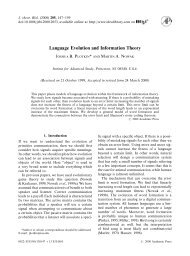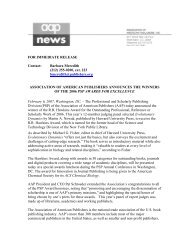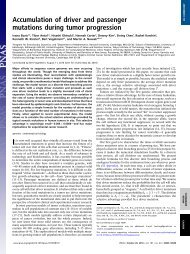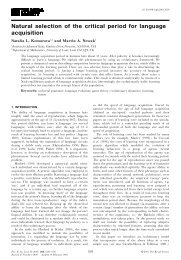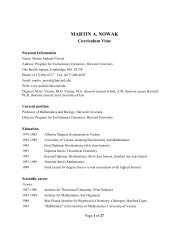Dr. Folkman's War: Angiogenesis and the Struggle to Defeat Cancer ...
Dr. Folkman's War: Angiogenesis and the Struggle to Defeat Cancer ...
Dr. Folkman's War: Angiogenesis and the Struggle to Defeat Cancer ...
Create successful ePaper yourself
Turn your PDF publications into a flip-book with our unique Google optimized e-Paper software.
BOOK REVIEW<br />
© 2001 Nature Publishing Group http://medicine.nature.com<br />
© 2001 Nature Publishing Group http://medicine.nature.com<br />
that biologists must h<strong>and</strong>le. Now, try<br />
some realpolitik: HIV invading <strong>the</strong> immune<br />
system with antigen-specific immune<br />
responses kicking in within days,<br />
<strong>the</strong> virus preying on <strong>the</strong> very T helper<br />
cells needed <strong>to</strong> orchestrate immune response,<br />
persistence despite ferocious immune<br />
responses, <strong>and</strong> genetic variation<br />
like we’ve never seen before. The immune<br />
system behaves not like a wellmixed<br />
Erlenmeyer flask, but ra<strong>the</strong>r as a<br />
highly delocalized ensemble of clonal<br />
sites that <strong>to</strong>ge<strong>the</strong>r make <strong>the</strong> famous polyclonal<br />
response. Studying such complexity<br />
requires solid data <strong>and</strong> analyses.<br />
Martin Nowak <strong>and</strong> Bob May have<br />
spent many years modeling <strong>the</strong> dynamics<br />
of this devastating viral infection.<br />
HIV is <strong>the</strong> Big One, measuring a 9 on<br />
<strong>the</strong> virological Richter scale.<br />
Accordingly, Nowak <strong>and</strong> May take <strong>the</strong><br />
problem head on, making few concessions<br />
<strong>to</strong> <strong>the</strong> unwary reader—<strong>the</strong> subtitle<br />
says it all, <strong>the</strong> ma<strong>the</strong>matical principles<br />
of immunology <strong>and</strong> virology. Let’s put<br />
it this way, <strong>the</strong> book contains more<br />
than a h<strong>and</strong>ful of equations.<br />
The modern era of viral dynamics<br />
dawned in January 1995, marked by two<br />
highly referenced papers that described<br />
<strong>the</strong> effect of powerful anti-HIV protease<br />
inhibi<strong>to</strong>rs in combination with extant<br />
anti-reverse transcriptase drugs. Plasma<br />
viremia was moni<strong>to</strong>red by quantitative<br />
PCR, Ah! PCR again, where would we be<br />
without Taq polymerase? Within days of<br />
treatment, plasma viremia was knocked<br />
down 2 <strong>to</strong> 3 logs. By applying a zest of<br />
analysis, <strong>the</strong> titanic struggle between <strong>the</strong><br />
virus <strong>and</strong> <strong>the</strong> host responses became immediately<br />
obvious. Questions such as<br />
what are <strong>the</strong> half-lives of productively infected<br />
cells <strong>and</strong> plasma viremia could<br />
now be addressed. Retrospectively it is<br />
clear that telltale signs came before, but<br />
combination <strong>the</strong>rapy was <strong>the</strong> seminal<br />
advance. For <strong>the</strong> record, ‘pre-modern’<br />
viral dynamics goes back <strong>to</strong> <strong>the</strong> late<br />
1950s with <strong>the</strong> determination of halflives<br />
of perfused virus in peripheral<br />
blood. Elegant stuff by <strong>the</strong> way.<br />
Nowak <strong>and</strong> May cover all <strong>the</strong> major<br />
areas of interest of HIV dynamics, including<br />
<strong>the</strong> emergence of drug resistance,<br />
cell-mediated immune responses (antibodies<br />
are barely mentioned), some<br />
minutiae of quasispecies <strong>and</strong> so forth,<br />
much of which is excellent. There is a<br />
model for all seasons, <strong>and</strong> variations on a<br />
<strong>the</strong>me, which are occasionally ra<strong>the</strong>r<br />
sparingly explained for <strong>the</strong> biologist, follow<br />
in a rapid succession. The book is entitled<br />
viral dynamics, <strong>and</strong> included are<br />
interesting data from hepatitis B virus<br />
worthy of comment, although no allusion<br />
is made <strong>to</strong> hepatitis C virus.<br />
The control of viremia by combination<br />
<strong>the</strong>rapy or by virus-specific cy<strong>to</strong><strong>to</strong>xic T<br />
lymphocytes (CTL) is a fascinating comparison.<br />
Using multiple drugs <strong>to</strong> hold<br />
down HIV is based on <strong>the</strong><br />
idea that <strong>the</strong> probability of<br />
finding a mutant simultaneously<br />
resistant <strong>to</strong> three<br />
drugs is less than for two,<br />
<strong>and</strong> four drugs less than for<br />
three, <strong>and</strong> so on. If <strong>the</strong><br />
probability is less than <strong>the</strong><br />
inverse of HIV population<br />
size in <strong>the</strong> body, <strong>the</strong> virus<br />
can’t out-maneuver <strong>the</strong><br />
drugs. When it comes <strong>to</strong> escape<br />
from CTL, <strong>the</strong> same<br />
rule applies—tie down<br />
Gulliver with as many<br />
ropes as possible. This is so efficient a<br />
strategy that <strong>the</strong> number of convincing<br />
cases of CTL-escape is trivially small.<br />
Indeed, presenting peptide epi<strong>to</strong>pes with<br />
polymorphic molecules is a marvelous<br />
way of dealing with viruses that mutate<br />
approximately one million times faster<br />
than <strong>the</strong>ir hosts.<br />
How well do Nowak <strong>and</strong> May succeed?<br />
Let’s back up one on viral dynamics <strong>and</strong><br />
first look at viral quasispecies, which preceded<br />
viral dynamics. Although modeled<br />
precisely on, <strong>and</strong> of relevance <strong>to</strong>, viruses<br />
cultured ex vivo, <strong>the</strong> concept of viral quasispecies<br />
has not helped advance our in<br />
vivo underst<strong>and</strong>ing. Instead, it has become<br />
little more than a euphemism for<br />
genetic heterogeneity. Back <strong>to</strong> dynamics.<br />
Looking at <strong>the</strong> profusion of equations I<br />
ran, not only for cover, but <strong>to</strong> try <strong>to</strong> work<br />
out what some of <strong>the</strong> terms might correspond<br />
<strong>to</strong> in <strong>the</strong> real world of lymphoid<br />
organs. Again, <strong>the</strong> immune system is not<br />
a well-stirred Erlenmeyer flask—oligoclonal<br />
foci are legion. Antigenic stimulation<br />
of latently HIV-infected T cells<br />
occurs locally. This introduces a s<strong>to</strong>chastic<br />
fac<strong>to</strong>r in<strong>to</strong> <strong>the</strong> amplification of HIV<br />
genotypes, for expansion of <strong>the</strong> variant<br />
harbored by a cell has nothing <strong>to</strong> do with<br />
<strong>the</strong> intrinsic fitness of <strong>the</strong> variant. With<br />
an extraordinary rate of viral recombination<br />
(2–3 crossovers per cycle!), multiply<br />
infected cells, phenomenal turnover of<br />
virions <strong>and</strong> destruction of infected cells<br />
that must result in strong bottlenecking,<br />
how is genotype (fitness) conserved?<br />
Spatial discontinuities may be hard <strong>to</strong><br />
h<strong>and</strong>le ma<strong>the</strong>matically, but in <strong>the</strong> case<br />
of <strong>the</strong> immune system it<br />
is a trademark.<br />
It is not yet obvious<br />
that <strong>the</strong> modeling of HIV<br />
dynamics has profoundly<br />
changed our ideas of HIV<br />
pathogenesis. The virologists<br />
<strong>and</strong> <strong>the</strong>ir clinical colleagues<br />
are still <strong>the</strong><br />
trailblazers. Yet it is easy<br />
<strong>to</strong> break along party lines,<br />
with <strong>the</strong> biologists bemoaning<br />
<strong>the</strong> complexity<br />
of <strong>the</strong> ma<strong>the</strong>matics <strong>and</strong><br />
simplifying assumptions,<br />
yet making no effort <strong>the</strong>mselves <strong>to</strong> grapple<br />
with <strong>the</strong> discipline necessary <strong>to</strong> h<strong>and</strong>ling<br />
numerous variables. On <strong>the</strong> o<strong>the</strong>r<br />
side, <strong>the</strong> ma<strong>the</strong>maticians may applaud<br />
<strong>the</strong> foray of <strong>the</strong>ir own in<strong>to</strong> something as<br />
extraordinarily complex as virology. The<br />
pathologist might well remark on <strong>the</strong> exquisite<br />
spatial architecture of a lymph<br />
node, <strong>and</strong> note dryly that pathogenesis<br />
cannot be unders<strong>to</strong>od by <strong>the</strong> molecular<br />
biologist working with tissue culture<br />
alone. Point.<br />
As <strong>the</strong> virological, immunological <strong>and</strong><br />
ma<strong>the</strong>matical plates become interlocked<br />
<strong>the</strong>re are bound <strong>to</strong> be shocks <strong>and</strong> shakeups.<br />
This book is a good move in <strong>the</strong><br />
right direction. It made me think about<br />
HIV pathogenesis. Early on in <strong>the</strong> book<br />
Nowak <strong>and</strong> May make a plea for discipline<br />
<strong>and</strong> responsibility in thought. The<br />
next time I use circle <strong>and</strong> arrow<br />
metaphors I’ll know who will be looking<br />
over my shoulder.<br />
526 NATURE MEDICINE • VOLUME 7 • NUMBER 5 • MAY 2001




